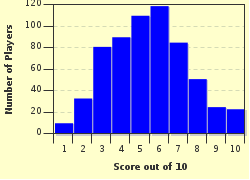Quiz Answer Key and Fun Facts
1. What is the IUPAC (and also common) name for cyclohex-1,3,5-triene?
2. What catalyst is used during the hydrogenation of alkynes?
3. Potassium permanganate is a stronger oxidizer than potassium dichromate.
4. What is glycerin?
5. What are polyunsaturated compounds?
6. Which catalyst is used to oxidize naphthalene into phthalic acid?
7. What metal ion is the oxidizing agent in Tollens' reagent?
8. What does the fact that alcohols react with highly reducing metals (such as sodium) prove?
9. Chloroethylene is used to produce PVC.
10. Which of these alkynes has the lowest melting point?
Source: Author
Canaris
This quiz was reviewed by FunTrivia editor
crisw before going online.
Any errors found in FunTrivia content are routinely corrected through our feedback system.


